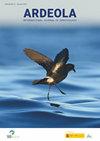不同鸟类翅膀形状的年龄相关差异:尺寸约束主成分分析(SCCA)中指向指数(C2轴)解释的意义
IF 1.2
4区 生物学
Q2 ORNITHOLOGY
引用次数: 2
摘要
总结。鸟类的翅膀形态与飞行方式有密切的关系。机翼形状与机动性、飞行速度、飞行过程中的能量消耗和起飞速度有关。人们经常研究不同物种之间翅膀形状的差异,但也可以在物种内部、性别之间和年龄组之间发现差异。许多研究已经评估了不同雀形目的幼鸟和成年鸟翅膀形状的差异,但对其他鸟类的这种差异知之甚少。采用尺寸约束成分分析(SCCA)和图形逼近法,对3目4种雀形目和4种非雀形目8种幼鸟和成鸟的翅膀形状进行了分析。根据图形近似,我们观察到不同年龄组之间翅膀形状的差异在不同物种之间存在差异。在考虑的非雀形目物种中,幼鸟的翅膀比成年鸟的翅膀更尖和凹。相比之下,在四种雀形目中,幼鸟的翅膀比成年鸟的更圆。然而,SCCA的C2轴(指向指数)的结果并不完全符合图形近似。我们的研究结果表明,C2轴并不代表所有物种翅膀形状变化的相同矢量。C2的变化对翼尖变化的贡献似乎取决于翼尖的位置,只有当翼尖位于最末端的两根原始羽毛中时,翼尖才是一个很好的指向指标。令人惊讶的是,一些物种的成年鸟的翅膀并不比相应的幼鸟长,因为在第一次完全换毛期间,定义翼尖的羽毛并没有长得更长。我们讨论了第一次完整的换羽在改变幼鸟翅膀形状到成年翅膀中的作用,以及我们的结果对鸟类翅膀形状分析的意义。-Cabodevilla, X., p本文章由计算机程序翻译,如有差异,请以英文原文为准。
Age-Related Variation in Wing Shape Differs between Bird Orders: Implications for Interpretation of the Pointedness Index (C2 Axis) in a Size-Constrained Principal Component Analysis (SCCA)
Summary. There is a strong relationship between bird wing morphology and flight style. Wing shapes are related to manoeuvrability, flight speed, energetic costs during flight and take-off speed. Wing shape differences among species have been frequently studied but differences can also be found within species, between sexes and age groups. Many studies have assessed differences in wing shape between juveniles and adults in different passerine species but little is known about such differences in other bird orders. Performing a Size Constrained Components Analysis (SCCA) and a graphical approximation, we analysed the wing shape of juveniles and adults of eight species, including four passerines and four non-passerines of three different orders. According to a graphical approximation, we observed that wing shape differences between age groups differ among species. In the non-passerine species considered, juveniles have more pointed and concave wings than adults. In contrast, in the four passerine species, juveniles have more rounded wings than adults. However, the results for the C2 axis of SCCA (index of pointedness) do not completely agree with the graphical approximation. Our results showed that the C2 axis does not represent the same vector of wing shape variation in all species. The contribution of changes in C2 to variation in wing pointedness seemed to depend on the position of the wing tip, which is a good index of pointedness only when the wing tip is in the two most distal primary feathers. Surprisingly, the adults of some species do not have longer wings than the corresponding juveniles, because the feathers that define the wing tip do not grow longer during the first complete moult. We discuss the role of the first complete moult in changing the shape of juvenile wings into adult wings, and the implications of our results for the analysis of bird wing shape.—Cabodevilla, X., Pérez-Tris, J., Moreno-Zarate, L., Pérez-Rodríguez, A., Lima-Barbero, J.F., Cruz Camacho, M., Villanua, D., Ibáñez, R., Gerboles, A. & Arroyo, B. (2020). Age-related variation in wing shape differs between bird orders: implications for interpretation of the pointedness index (C2 axis) in a size-constrained principal component analysis (SCCA). Ardeola, 67: 341-354.
求助全文
通过发布文献求助,成功后即可免费获取论文全文。
去求助
来源期刊
CiteScore
2.30
自引率
6.20%
发文量
16
审稿时长
>12 weeks
期刊介绍:
Ardeola: International Journal of Ornithology is the scientific journal of SEO/BirdLife, the Spanish Ornithological Society. The journal had a regional focus when it was first published, in 1954. Since then, and particular during the past two decades, the journal has expanded its thematic and geographical scope. It is now a fully international forum for research on all aspects of ornithology. We thus welcome studies within the fields of basic biology, ecology, behaviour, conservation and biogeography, especially those arising from hypothesis-based research. Although we have a long publication history of Mediterranean and Neotropical studies, we accept papers on investigations worldwide.
Each volume of Ardeola has two parts, published annually in January and July. The main body of each issue comprises full-length original articles (Papersand Review articles) and shorter notes on methodology or stimulating findings (Short Communications). The publication language is English, with summaries, figure legends and table captions also in Spanish. Ardeolaalso publishes critical Book Reviewsand PhD-Dissertation Summaries; summarising ornithological theses defended in Spain. Finally there are two Spanish-language sections, Ornithological News; summarising significant recent observations of birds in Spain, and Observations of Rare Birds in Spain, the annual reports of the Spanish Rarities Committee.

 求助内容:
求助内容: 应助结果提醒方式:
应助结果提醒方式:


